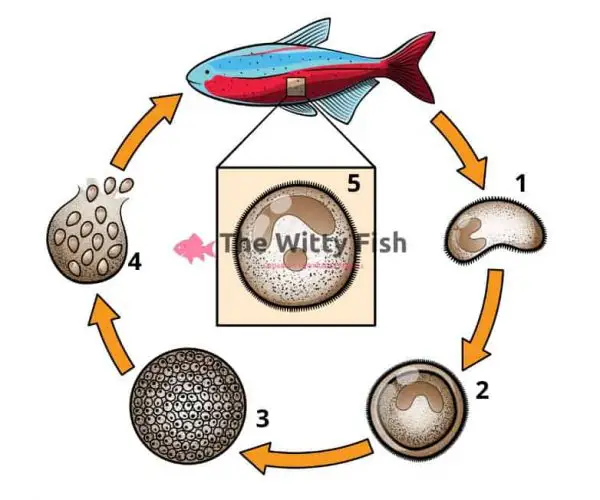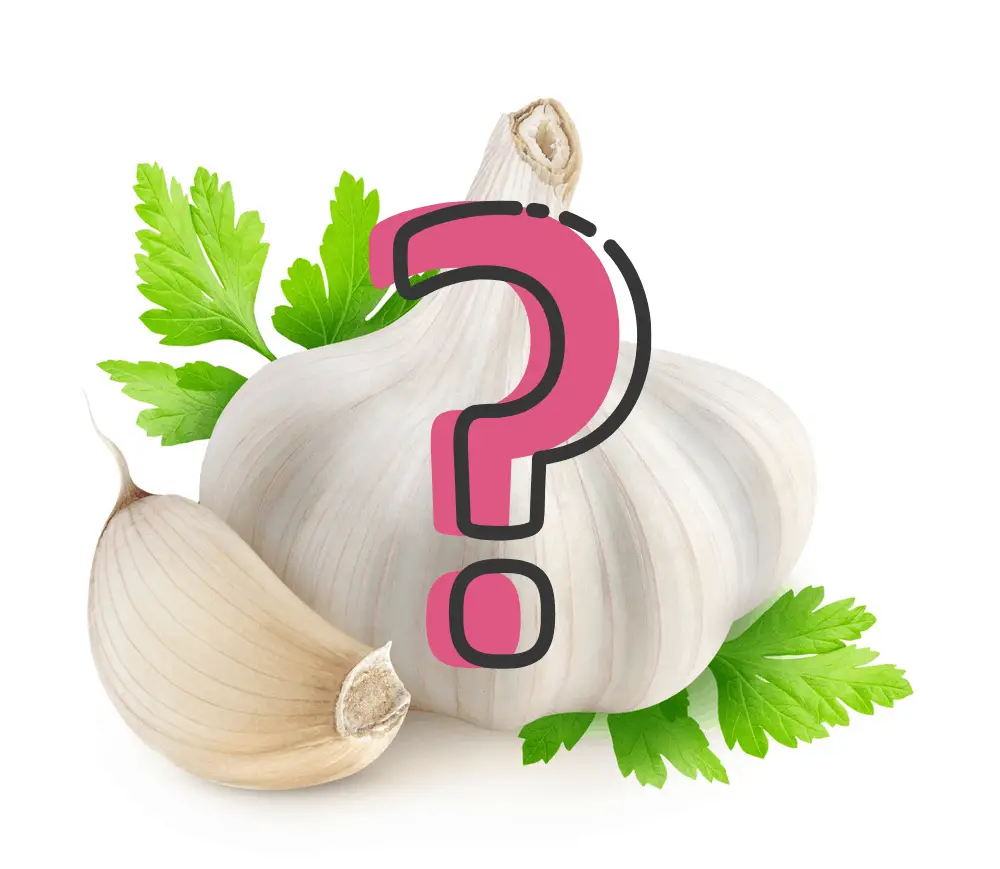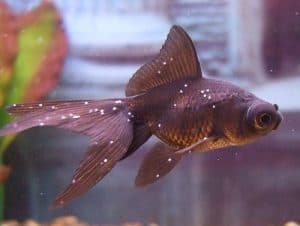Picture this. You’ve got a great aquarium full of lively fish. Maybe it’s a new aquarium. Maybe you just added some fish from the pet store. Either way, your excitement soon turns to alarm when you notice your fish acting strangely. Even more alarming are the little white spots all over your fish.
You’ve got Ich!!! Ichthyophthirius multifiliis or white spot disease is one of the most common and persistent fish diseases.
This resource has been created to teach fish keepers everything they need to know about Ich.
What Exactly is Ich?
Ichthyophthirius multifiliis is a parasitic protozoa that causes Ichthyophthiriasis. This is more commonly known as “white spot disease” or simply “Ich”. Ich is an obligate parasite, meaning it must have a fish host to survive. Although parts of its lifecycle are spent in the open water.
This protozoan has multiple life cycles. The most notable being the phase where it causes visible white cysts. Ich spreads quickly and if left untreated will lead to 100% mortality in fish.
Ich likely originated in Asia and was introduced to Europe in the middle ages. It later spread to North America and the rest of the world through the goldfish trade (source).
Ich Life Cycle
In order to prevent and treat Ich we need to first understand its life cycle. The three distinct life stages of Ich are the tomont, theront, and trophont.

Life Cycle Stages of Ichthyophthirius multifiliis
1. Exiting Tomont 2. Tomont Cyst 3. Dividing Tomonts within cysts 4. Infective theronts leaving cyst 5. Dividing tomites within cyst on fish
Tomont
When a trophont leaves an infected fish it becomes a protomont. These protomonts will attach to any available surface and form thin-walled cysts called tomonts.
Within the tomonts are tomites. These are the reproductive start of a new life cycle for Ich. They can be thought of as eggs that will later hatch and start a new life cycle.
Within the safety of these cysts the tomite cells will divide multiple times to produce anywhere from 100 to 1,000 theronts per cyst.
Theront
The theront is the infectious stage of Ich. Once they are mature in the tomite cyst they bore their way out and are released into the water. At this stage, the theronts are mobile and can swim in search of a host fish.
This swimming is performed with cell appendages called cilia. These motile cilia are hairlike appendages that beat in coordinated waves providing motion.
If they are successful in finding a host they burrow into the fish’s epithelium. This is accomplished by the theront using its penetrating gland and strong swimming action.
Theronts must find a host within 2 to 3 days. If they are not able to find a host in this time period they will soon die. This is also the stage that Ich is vulnerable to treatments.
Trophont
Once the theront finds and burrows into its host fish it becomes a trophont. These trophonts will begin to feed on the fish. This feeding causes tissue damage to the fish and will eventually lead to death.
The Trophont will mature in cysts that begin to form under the fish’s epithelium. These cysts create the visible white spots that Ich is known for.
In this protective cyst, it is protected from all known treatments meant to eradicate Ich. Once it has fully matured it will leave the fish to form a tomont and the cycle repeats.
Life Cycle Timeframe
The rate or time it takes Ich to complete this cycle varies. The main factor that determines this life cycle speed is water temperature.
Ich thrives in temperatures ranging from 68-80°F/20-27°C. At 78-80°F, a complete life cycle can take as little as 8 hours! (source)
At cold temperatures less than 45°F/7°C a complete life cycle can take up to 5 weeks. It cannot reproduce at temperatures above 85° F. (source). This is important to remember as this is one strategy in combating Ich.
How does Ich kill fish?
Ich doesn’t necessarily kill fish outright. But it does cause a host of issues for the fish that leave it in a weakened and stressed state. The gills are especially vulnerable to Ich infestation. Once infested the gill cells will thicken and deform. This results in a restriction in oxygen uptake by the gills.
This suffocation is why fish infected with Ich will often be found by water inlets or bubblers. The fish will seek out these higher oxygen areas in an attempt to breathe.
The damage goes beyond the gills. The theronts will attach anywhere they can on the fish’s body. When attached to the body the fish’s epithelium and mucous membrane are also compromised. This can leave the fish prone to secondary infections.
All of this results in a very stressed fish that is far more susceptible to mortality from a variety of causes.
Identifying Ich
Now that we understand Ich, how do we positively identify it? The primary way Ich is identified is by the telltale white spots it leaves on fish.
In a full-on outbreak, they will likely have these spots all over their bodies. Some people say it makes the fish look like they have been sprinkled with salt.
Other times, however, there will only be white spots on the gills of the fish. You may also see large amounts of mucus shedding off of the fish’s skin.
As the infection takes hold, changes in behavior will also start to become apparent. One of the first behaviors exhibited by a sick fish will be rubbing or scratching against things. This is due to the extreme irritation the cysts cause to the fish’s skin. This behavior will sometimes look frantic or violent.
As the disease progresses further the fish will become sluggish and refuse to eat. They will often congregate around water filter outlets or airstones. The fish do this because they are having difficulty breathing and these areas have more oxygen.
Ich is sometimes confused with Lymphocystis. With this disease, however, the white spots tend to be more clustered around the fins. If there is any doubt the only sure way to identify the disease is for a qualified veterinarian to take a sample and examine it.
White Spot Disease Signs & Symptoms
- White spot cysts
- Fins clamped next body
- Cowering at top or bottom of tank
- Congregating around oxygen sources
- Rubbing or scratching against surfaces
- Flashing
- Reduced appetite
- Short choppy gill movements
Preventing Ich
It goes without saying that Ich is some pretty nasty stuff. The best way to deal with it is to never get it in the first place. Prevention is key!
The single best way to prevent Ich in your aquarium is to quarantine all new fish or live plants. This will require an extra aquarium but it need not be large or extravagant.
There are a wide variety of diseases that can hitch a ride on your new fish or plants. For this reason, it is best to quarantine them for at least 4 weeks but longer is better. During this time most diseases should reveal themselves.
With live plants its best to buy them from tanks without fish. If they have never been exposed to fish-bearing water Ich is much less of a concern.
Other prevention measures are focused on preventing stress. This includes minimizing transport time, not overstocking your tank, regular water changes, and so on.
While these practices don’t eliminate the possibility of Ich, they do give your fish a fighting chance.
How to Treat Ich
So what do we do once we have identified an Ich outbreak? Treatment is essential for the survival of every fish in the aquarium.
As I alluded to earlier when talking about life cycle stages, Ich cannot be treated once it has infected the fish. The cysts that are formed on the fish provide a protective layer for the trophont.
So what do we do once we have identified an Ich outbreak? Treatment is essential for the survival of every fish in the aquarium.
As I alluded to earlier when talking about life cycle stages, Ich cannot be treated once it has infected the fish. The cysts that are formed on the fish provide a protective layer for the trophont.
What needs to be done is to interrupt the life cycle of Ich. Ich can only be effectively killed in the open water theront stage.
Because of this, multiple treatments will need to be performed to catch any newly hatched theronts. There are a variety of ways to interrupt and kill Ich during this vulnerable lifecycle stage.
Even with effective treatment, your fish will still be stressed and some may still die.
Treating Ich With Heat
As I mentioned when explaining the lifecycle, Ich cannot reproduce at higher temperatures. Using heat on its own is generally the easiest and safest way to treat for Ich. But it may not be the most effective.
With this method, the water temperature is increased to 86°F/30°C.
This should be done gradually at a rate of about 2°F/1°C per hour. This increased temperature should be maintained for 10-14 days. After this period the temperature can be gradually reduced back down at the same rate.
Be aware that warmer water holds less dissolved oxygen. To make this worse fish infected with Ich are already having a hard time breathing.
With this in mind, you need to add more aeration to the water. If you don’t already have a bubbler or airstone add one. If you already have one increase the output or add a second.
There is some disagreement about the effectiveness of using heat alone. Some have had great success with it and some have not. This may be due to the fact that there is a Florida strain that can successfully reproduce up to 92°F/33°C. This strain is not as common however and most will die off at 86°F/30°C.
To increase the effectiveness of using heat salt can be added as well. This is explained below.
Treating Ich with Salt
Using salt in conjunction with heat will increase the effectiveness of the treatment. This is a harsher treatment however and should not be used with some soft water species such as Cories. Salt may also harm live aquarium plants and snails.
Salt kills the Ich protozoa in the theront stage by affecting cell osmosis. In simple terms, this means that salt causes cell death by dehydration.
To be clear, we are talking about using regular table salt aka sodium chloride. Not iodized table salt, Epsom salt, or marine salt. To be sure you are getting the right salt, buy “aquarium salt” for freshwater aquariums.
You will need to add 1 tsp of salt per 1 gallon/4 liters of water. Do this by diluting the salt in some warm water. Then slowly pour this saltwater in over the course of a few hours.
Using salt in conjunction with heat will kill off Ich within 1 to 2 weeks. Once this period is up reduce the salt back down through a series of weekly water changes.
Treating Ich With Medications
When all else fails, there are a few different medications at our disposal for serious Ich infestations. It is not recommended to use extreme heat alongside these medications.
But you should maintain a temperature of at least 80°F/27°C. This will shorten the Ich lifecycle which will, in turn, shorten the needed treatment time.
The most common medications are malachite green, methylene blue, formalin, and copper-based medicines. Popular products will often mix these primary ingredients with others in proprietary blends. Popular brands include Kordon Rid Ich Plus, Hikari Ich X, and Seachem ParaGuard.
Most of these medications will stain the water a blue or green color. They will also likely kill the beneficial bacteria in your aquarium responsible for nitrogen cycling. For these reasons, I recommend moving the fish to a smaller “hospital tank” and treating them there.
With the now fishless primary tank increase the temperature to above 80°F/27°C. In a week or two, all the theronts should hatch and die without an available fish host.
If you purchase one of these products make sure you read the directions. Many of them are fatal to invertebrates. Dosing frequency and length also vary somewhat based upon water temperature.
When using one of these medications it is also important to remove the charcoal filter if you have one. These will absorb much of the medication from the water where it is needed.
Treating Ich with Garlic?
Treating Ich with garlic is a concept that re-appears every so often. There has been a study performed that shows garlic extract can kill Ich in the lab (source). While it sounds like it would be a nice natural cure it isn’t that simple.
In the study, only high doses of garlic extract had any effect. Unfortunately, it is impractical to treat an aquarium this way.

Having said that, garlic still does have some benefit when added to fish food. It helps to stimulate a fish’s appetite when they are stressed and may boost their immune system as well.
There are a variety of store-bought fish foods that include garlic but you can add it to fish food yourself.
Final Thoughts on Ichthyophthirius multifiliis
If you have been or plan to be in the fish keeping hobby for any amount of time you will have to deal with Ich sooner or later. I hope this article gave you the info you need to tackle white spot disease head-on.
Happy fish keeping!

